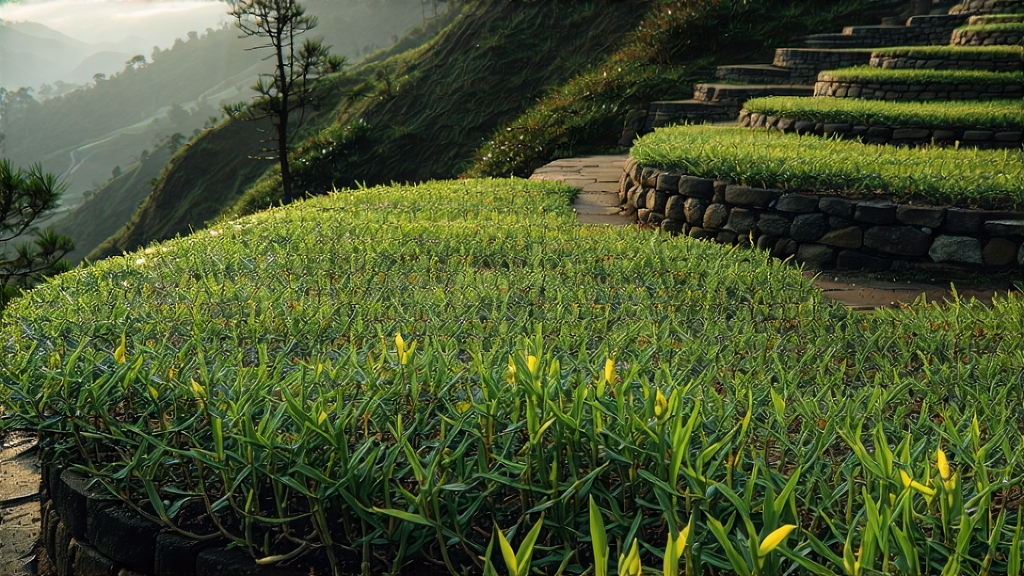
Tucked high above the Sichuan basin, where the Min River bends like a silk ribbon around peaks that never quite release their morning mist, lies Meng Ding Mountain—home to the oldest recorded tea garden in China and the birthplace of Meng Ding Huang Ya, the “Yellow Bud of Meng Ding.” Few outside the Middle Kingdom have tasted it, fewer still understand why its leaves glow like pale gold or why an emperor once decreed that every spring it should travel 1,800 km by relay horse to the Forbidden City. This essay invites the global tea lover to discover a tea that occupies the thinnest sliver of China’s production—less than 0.3 %—yet carries the full weight of thirteen centuries of lore, artistry, and sensory surprise.
-
A leaf born of poetry and politics
The first written mention appears in 724 CE, when the Tang poet-priest Meng Haoran praised “a bud of golden frost plucked before the Qingming bell.” By 880 CE the leaf was taxed as “tribute of the sixth rank,” and the Song court’s Tea Bureau assigned 120 masons to carve 3 km of stone steps so pickers could reach the 1,450 m terraces before dawn. When the Ming Hongwu Emperor abolished compressed tribute cakes in 1391, Meng Ding Huang Ya survived the purge by reinventing itself as a loose, yellowed leaf—an early example of artisanal adaptation to regulatory shock. Thus, while green teas dominated Jiangnan and dark pu-erh caravans lumbered toward Tibet, the yellow bud quietly perfected a technique that would later be called “sealed yellowing,” a slow oxidation no other tea category dares to attempt. -
Micro-terroir in the land of clouds
Meng Ding enjoys a unique three-climate stack: subtropical valley air rises 1,000 m overnight, meets a cool subtropical alpine layer, and is capped by a 200 m cloud curtain that filters UV into soft amber. The result is a diurnal swing of 12 °C even in April, forcing the tea bush (a local clone of Camellia sinensis var. sinensis known as “xiao ye zhong,” small-leaf Sichuan) to synthesize more theanine and less catechin. Soils are Phyllite-derived, slightly acidic (pH 5.1), and laced with selenium leached from ancient marine shales. Together these factors create a leaf that is naturally low in astringency yet high in soluble sugars—ideal substrate for the yellowing enzymatic cascade that follows. -
The six-day secret: sealed yellowing demystified
Unlike green tea, whose kill-green step locks color and fragrance within minutes, Meng Ding Huang Ya is coaxed into a controlled “second life.” After plucking one bud and the unopened first leaf (standard 1.5–2.0 cm length), the leaves are withered for 3 h at 28 °C to shed 8 % moisture. A brief 2 min 220 °C pan-fire denatures surface enzymes but leaves inner-cell activity intact. The crucial act follows: the warm leaves are piled 8 cm deep inside linen bags, then slid into a pine-wood cabinet lined with wet rice paper. For 48 h the cabinet interior hovers at 34 °C and 75 % RH; polyphenol oxidase and peroxidase re-activate, converting catechins into theaflavins and generating a yellow pigment—tea flavin-3-gallate—unique to yellow tea. Every 12 h the pile is gently turned by hand to equalize temperature; the master judges readiness by aroma shift from fresh bean to chestnut-honey. A second low-temperature pan-fire (85 °C, 7 min) halts oxidation, followed by a slow charcoal bake at 55 °C for 4 h. The entire cycle spans six days, ten times longer than green tea processing, explaining both rarity and cost. -
Grades and visual grammar
Mingqian Pre-Qingming buds (picked before 5 April) are classified into three grades:- Imperial Tip (牙尖): 100 % single bud, needle-shaped, downy, liquor the color of chardonnay.
- Gold Sparrow (金雀): bud plus half-open first leaf, slight curve like a bird in flight.
- Gentle Fan (雅扇): bud and one full leaf, flattened during the final bake to resemble a folded fan.
Each grade shares